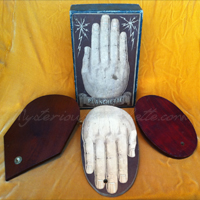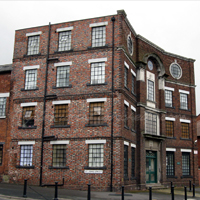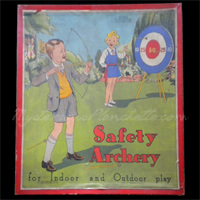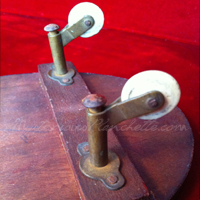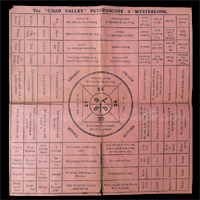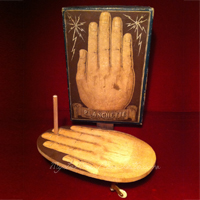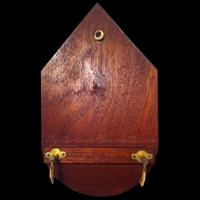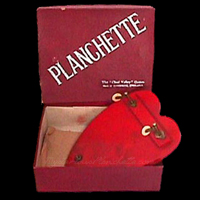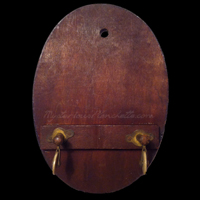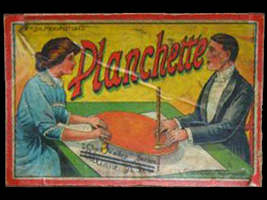Chad Valley is an exceptionally prolific and long-lived brand of toys manufactured in the United Kingdom. Like many planchette makers both British and American, it has its roots in printing and bookbinding, founded as it was in the early 1800s by publisher Anthony Bunn Johnson. By the turn of the century, the family-run company was well-established, and a move orchestrated by his son Joseph relocated their factory to a newly-constructed building in Harbourne, England, where a small local stream called the Chad lent the reconfigured company its new name: Chad Valley Works. The stationers began expanding their endeavors into toys and games, including such favorites as Ludo, Helter-Skelter, and other pseudo-sporting goods titles, such as the rinky-dink "Safety Archery" set. The firm weathered the many storms that hit the British toys industry in subsequent years-including World War I, which also opened up new opportunities as imported toys became rare and domestic products were able to establish a foothold. By the 1920s, the firm had established new factories and expanded production, and merged several factories under one banner: The Chad Valley Co Ltd. In 1938, British royalty even appointed Chad Valley "Toymakers to Her Majesty the Queen!"
Chad Valley contributed to the wartime efforts during WWII, producing few toys but manufacturing gun cases, mechanical parts, tables, clothing, and printed goods, though one factory did continue some toy production on a limited basis, making mostly wooden game tokens such as chess pieces, dominoes, and puzzles for use by the military personnel during leisure. In the 1950s and 60s, the company-like many other toy manufacturers of the period-went trough a great period of acquisition of smaller competitors, though this boom would be short lived, with all but two factories surviving into the early 1970s. Chad Valley was eventually acquired by Woolworths in the 1980s, then the parent company of the general-goods chain Argos, where the toys are now exclusively available.
The planchettes produced by Chad Valley likely date from their 1920s and 30s heydays, and some models would be difficult to identify were it not for the forensic evidence uncovered by our curator and similarities that allow us to group them, as the company did not mark all models with their brand name. The models almost all have distinctive castors that identify them, however, and the "tackhead" pin of the otherwise low budget pentagraph-style castors is usually a dead giveaway. They are always nailed to the plank's underside with small furniture tacks through the flared base of the castors. Fortunately, these nails do not penetrate the topside of the board.
Similar to the British Manufacture -possibly Chad Valley's close cousins-the planks came equipped with a fold-out fortune chart similar to the "Physio-Psychophone," though in this instance reconfigured and branded the "Futuroscope & Mystereone." Like others of its kind, it is covered in a plethora of fortunes worthy of a Las Vegas buffet, including the always uplifting "You Will Live & Die Alone." No doubt the reason most surviving specimens have the board's center roughly worn away from years of use is due to fortune-seekers steering well-clear of that prediction and others like it!
Given the company's roots in the printing business, it should come as little surprise that they produced some of the most beautiful planchette boxes ever witnessed. With the exception of the rather plain red box that seems to take its cue from their competitor H.P. Gibson's designs, the packages contain beautiful lithographs, from the dark and esoteric palmistry hand that graces the box top of the "Occult Talking Board" and "Arrowhead" models, to the full-color-if exaggerated-scene of a cute Edwardian couple scribbling the company's name with a hugely oversized board that conceals the rather meager plank within. The boards themselves are something of a paradox. Topside, the planks are well crafted, with either the high-sheen that results from a company that doesn't skimp on the varnish, or the same high-quality lithograph that graces their boxtops, lovingly pasted. The edges are un-beveled but smooth. Underneath, however, the quality takes a nose-dive, with poorly-attached pentagraph-style castors nailed to an extraneous strip of wood to provide more height, with often roughly-sanded, poorly-stained wood (if it is stained at all!) to display from the planks' bottom.
Several models by Chad Valley are known to exist. The most enigmatic copies the palmistry "Hand of Fate" from the various boxtops. From the underside, the board is typically Chad Valley, with the pentagraph castors nailed to a support board and total lack of stain or varnish, but once flipped topside for use, its beautifully engaging lithograph invites users to place their own hands upon it and see what fate awaits them. If the hand-written "Guess Your Weight!" receipt and stamped machine card found in the box are any indication to the origins of the board in our collection, we'd have to say that it was purchased from the Southport location of the Bobby & Co chain of department stores, nestled along the pleasure pier boardwalk there, mostly likely by a tourist taking part in the fun and games there who may or may not have been a fan of Ogden's "Robin" cigarettes. Apparently, the purchaser weighed 8 stones, 9 pounds (121 pounds-the barker was only off by 1 pound!), and acquired the item on August 16, 1934. No "Futuroscope" accompanied the box, however, and one can only speculate it was quickly trashed when such predictions as the one given above were pointed out!
Chad Valley was not afraid to break the mold and diverge greatly from the designs of other companies. Packaged in the same "Hand of Fate" box as the above board, the model we've nicknamed the "Arrowhead" is unlike any other planchette shape we've ever seen. The underside configuration is unmistakeably Chad Valley-castors, support board, and rough sanding-though the shape has a well-rounded rear and a sharply-pointed nose-the Bette Midler of boards, if you will. The dark stain nice sanding, and thick varnish topside, not to mention the fine brass pencil aperture, make this one a beauty, especially face down and in use.
In other boards, Chad Valley took a more traditional route. Nicknamed the "Red," this planchette carries the same distinctive marks of its siblings-"tackhead" pentagraph castors, support board and rough-sanded bottom-though it is painted bright red, and has the traditional heart shape of American planchettes. It is a sort of "Valentine" board, if you will. Unlike the "Hand of Fate" boxes, the Red is marked "The Chad Valley Company," firmly establishing its post-1920 manufacture and Harbourne origins, and includes the same Futuroscope ephemera as the other boards.
Lastly, never has such a dinky board come in such an attractive, misleading package. We call this lipstick-on-a-pig plank the "Mini," and its diminutive size gets lost in in absolutely stunning full-color and absolutely-misleading box depicting an Edwardian couple manipulating a hugely oversized board totally contrary to the tiny toy within. As for the board, all of the Chad Valley castor, sanding, and varnish hallmarks are present, though with plastic wheels rather than the bone of other models. In reality it appears cut from the same cloth as the "Arrowhead" model, with a slightly more reddish varnish. But the irregularly oval, stunted shape is nearly 3-inches shorter and 2-inches skinnier than its sister, making it a nearly-inoperable planchette at best. It also lacks the fine quality brass pencil aperture, a sure sign that corners were cut in its production, either from the disruptions of wartime England, or as a conscious effort to make more of a toy and less of a tool.







